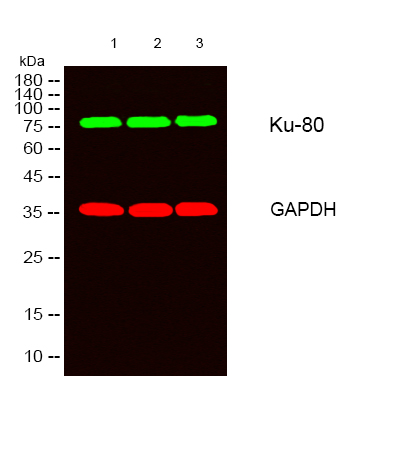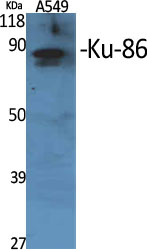VEGFR1 (PTR1311) mouse mAb
- Catalog No.:YM4719
- Applications:WB;IF;ELISA
- Reactivity:Human;
- Target:
- FLT1
- Gene Name:
- FLT1 FLT FRT VEGFR1
- Protein Name:
- Vascular endothelial growth factor receptor 1 (VEGFR-1) (EC 2.7.10.1) (Fms-like tyrosine kinase 1) (FLT-1) (Tyrosine-protein kinase FRT) (Tyrosine-protein kinase receptor FLT) (FLT) (Vascular permeabi
- Human Gene Id:
- 2321
- Human Swiss Prot No:
- P17948
- Mouse Gene Id:
- 14254
- Mouse Swiss Prot No:
- P35969
- Rat Gene Id:
- 54251
- Rat Swiss Prot No:
- P53767
- Immunogen:
- Synthesized peptide derived from human VEGFR1. AA range: 200-300
- Specificity:
- This antibody detects endogenous levels of VEGFR1 protein.
- Formulation:
- PBS, 50% glycerol, 0.05% Proclin 300, 0.05%BSA
- Source:
- Mouse, Monoclonal/IgG
- Dilution:
- WB 1:500-2000. IF 1:100-500. ELISA 1:1000-5000
- Purification:
- Protein G
- Concentration:
- 1 mg/ml
- Storage Stability:
- -15°C to -25°C/1 year(Do not lower than -25°C)
- Other Name:
- Vascular endothelial growth factor receptor 1 (VEGFR-1) (EC 2.7.10.1) (Fms-like tyrosine kinase 1) (FLT-1) (Tyrosine-protein kinase FRT) (Tyrosine-protein kinase receptor FLT) (FLT) (Vascular permeability factor receptor)
- Molecular Weight(Da):
- 151kD
- Observed Band(KD):
- 180kD
- Background:
- fms related tyrosine kinase 1(FLT1) Homo sapiens This gene encodes a member of the vascular endothelial growth factor receptor (VEGFR) family. VEGFR family members are receptor tyrosine kinases (RTKs) which contain an extracellular ligand-binding region with seven immunoglobulin (Ig)-like domains, a transmembrane segment, and a tyrosine kinase (TK) domain within the cytoplasmic domain. This protein binds to VEGFR-A, VEGFR-B and placental growth factor and plays an important role in angiogenesis and vasculogenesis. Expression of this receptor is found in vascular endothelial cells, placental trophoblast cells and peripheral blood monocytes. Multiple transcript variants encoding different isoforms have been found for this gene. Isoforms include a full-length transmembrane receptor isoform and shortened, soluble isoforms. The soluble isoforms are associated with the onset of pre-eclampsia.[provided by RefSeq, May 2009],
- Function:
- Tyrosine-protein kinase that acts as a cell-surface receptor for VEGFA, VEGFB and PGF, and plays an essential role in the development of embryonic vasculature, the regulation of angiogenesis, cell survival, cell migration, macrophage function, chemotaxis, and cancer cell invasion. Acts as a positive regulator of postnatal retinal hyaloid vessel regression (Ref.11). May play an essential role as a negative regulator of embryonic angiogenesis by inhibiting excessive proliferation of endothelial cells. Can promote endothelial cell proliferation, survival and angiogenesis in adulthood. Its function in promoting cell proliferation seems to be cell-type specific. Promotes PGF-mediated proliferation of endothelial cells, proliferation of some types of cancer cells, but does not promote proliferation of normal fibroblasts (in vitro). Has very high affinity for VEGFA and relatively low protein k
- Subcellular Location:
- Membranous
- Expression:
- Detected in normal lung, but also in placenta, liver, kidney, heart and brain tissues. Specifically expressed in most of the vascular endothelial cells, and also expressed in peripheral blood monocytes. Isoform 2 is strongly expressed in placenta. Isoform 3 is expressed in corneal epithelial cells (at protein level). Isoform 3 is expressed in vascular smooth muscle cells (VSMC).
- June 19-2018
- WESTERN IMMUNOBLOTTING PROTOCOL
- June 19-2018
- IMMUNOHISTOCHEMISTRY-PARAFFIN PROTOCOL
- June 19-2018
- IMMUNOFLUORESCENCE PROTOCOL
- September 08-2020
- FLOW-CYTOMEYRT-PROTOCOL
- May 20-2022
- Cell-Based ELISA│解您多样本WB检测之困扰
- July 13-2018
- CELL-BASED-ELISA-PROTOCOL-FOR-ACETYL-PROTEIN
- July 13-2018
- CELL-BASED-ELISA-PROTOCOL-FOR-PHOSPHO-PROTEIN
- July 13-2018
- Antibody-FAQs

